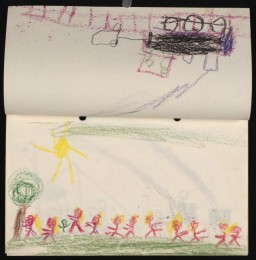
Artifact
Browse an alphabetical list of artifacts from the Holocaust and World War II. Each object tells a story about the history and demonstrates human experiences during the time period.
<< Previous | Displaying results 41-50 of 231 for "Artifact" | Next >>
-
Boots issued to Jacob Polak by the Red Cross
ArtifactSurvivors of the camps lacked even basic possessions, such as footwear. The Red Cross issued these United States Army boots to Jacob Polak in June or July 1945 after his repatriation to the Netherlands.

-
Boruch Golden's violin
ArtifactA childsize violin that belonged to Boruch Golden (Gordon), who was killed along with his mother and brother at the Ponary killing site in September 1943. Boruch was born in 1930, and was one of four children. His parents, Moshe and Basia Golden (Gordon), raised their family in Swieciany (Svencionys), Lithuania. After the German invasion of the Soviet Union in June 1941, the family was forced into the Swieciany ghetto. When that ghetto was later liquidated in 1943, the family was sent to the Vilna…
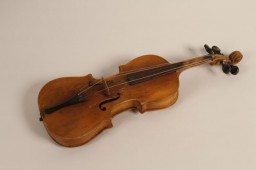
-
Boy Scout badges
ArtifactBoy Scout handmade badges worn by German-Jewish refugee boys. British expatriates had transplanted the Boy Scouts to Shanghai before the refugees' arrival. Unlike most of the Polish Jewish refugees, German and Austrian Jews usually went to Shanghai as families, and enrollment in schools and youth organizations in the International Settlement grew rapidly. [From the USHMM special exhibition Flight and Rescue.]
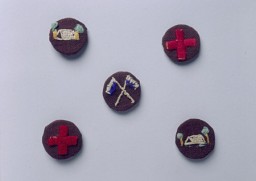
-
Buchenwald trial document
ArtifactDocument from the Buchenwald trial stating that both the prosecution and the defense teams agree to waive their right to make closing statements. The document is signed by the US military prosecutors (including William Denson), the defense lawyers, and the defendants. Dachau, Germany, August 8, 1947.
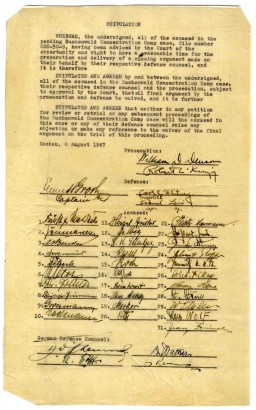
-
Candlesticks taken to Vilna by Polish Jewish refugees
ArtifactA pair of candlesticks, bought in Poland and used every Friday evening during observance of the Jewish Sabbath. Polish Jewish refugees fleeing the German invasion of Poland in 1939 carried these candlesticks with them to Vilna.

-
Casting of Majdanek gas chamber door
ArtifactThis casting of a gas chamber door in the Majdanek camp, near Lublin, Poland, was commissioned by the United States Holocaust Memorial Museum. Each gas chamber in Majdanek was fitted with an airtight metal door and was bolted shut before gas entered the chamber inside. SS guards could observe the killing process through peepholes in the upper center of the door.
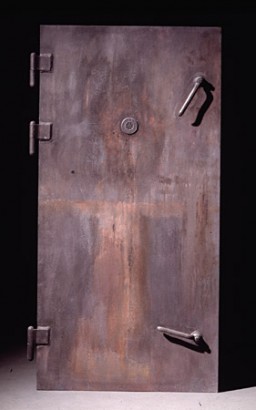
-
Chart of Prisoner Markings
ArtifactA chart of prisoner markings used in German concentration camps. Dachau, Germany, ca. 1938–1942. Beginning in 1937–1938, the SS created a system of marking prisoners in concentration camps. Sewn onto uniforms, the color-coded badges identified the reason for an individual’s incarceration, with some variation among camps. The Nazis used this chart illustrating prisoner markings in the Dachau concentration camp.
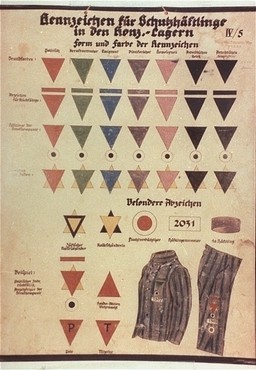
-
Children's art: Drawing of people in a garden
ArtifactAlice Goldberger (1897-1986) was born in Berlin, Germany. Trained as a youth-work instructor, she ran a shelter for disadvantaged children and their families. When Hitler came to power, Alice, who was Jewish, had to give up her post. She immigrated to England in 1939. When war broke out, Alice was interned on the Isle of Man as an enemy alien. While there, she organized a children's facility.Hearing of Alice's work in the camp, psychoanalyst Anna Freud (daughter of Sigmund Freud) intervened to secure her…

-
Children's art: Handmade comic book "To Alice from Ervin Bogner"
ArtifactAlice Goldberger (1897-1986) was born in Berlin, Germany. Trained as a youth-work instructor, she ran a shelter for disadvantaged children and their families. When Hitler came to power, Alice, who was Jewish, had to give up her post. She immigrated to England in 1939. When war broke out, Alice was interned on the Isle of Man as an enemy alien. While there, she organized a children's facility. Hearing of Alice's work in the camp, psychoanalyst Anna Freud (daughter of Sigmund Freud) intervened to secure…
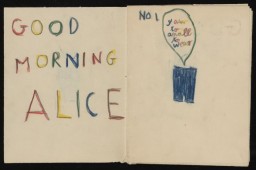
-
Children's art: "Lav Fritz," handmade pamphlet of drawings by Fritz Friedmann
ArtifactAlice Goldberger (1897-1986) was born in Berlin, Germany. Trained as a youth-work instructor, she ran a shelter for disadvantaged children and their families. When Hitler came to power, Alice, who was Jewish, had to give up her post. She immigrated to England in 1939. When war broke out, Alice was interned on the Isle of Man as an enemy alien. While there, she organized a children's facility. Hearing of Alice's work in the camp, psychoanalyst Anna Freud (daughter of Sigmund Freud) intervened to secure…
